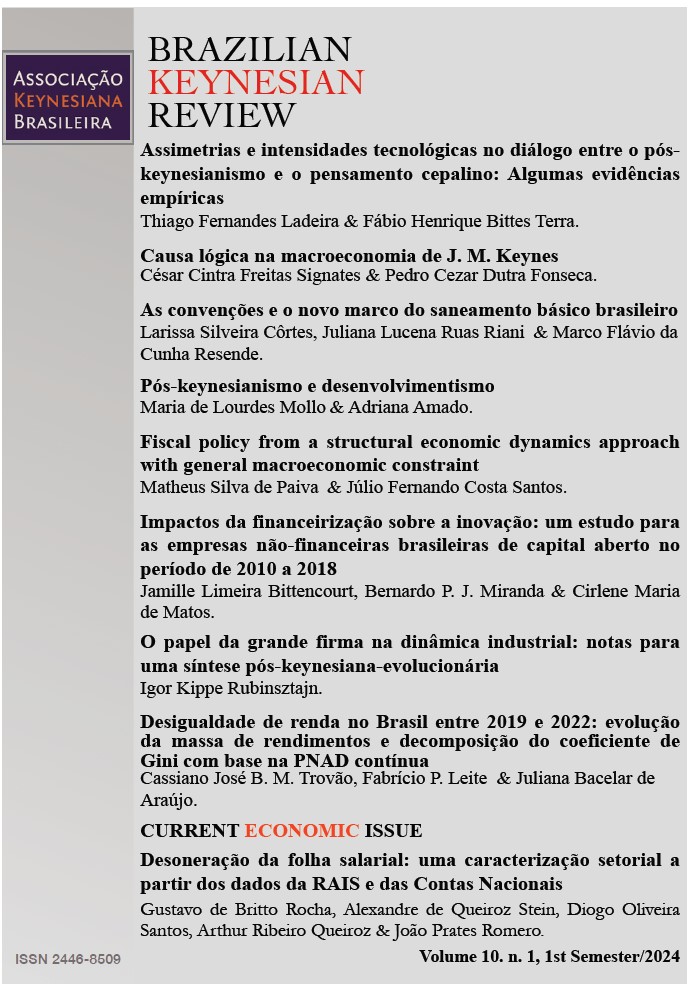Fiscal Policy from a Structural Economic Dynamics Approach with General Macroeconomic Constraint
Resumo
The aim of this paper is to analyze how fiscal policy can affect per capita economic growth. Therefore, an extension of the model by Araujo and Lima (2007) was made, by considering the public sector taxation and public expenses. Our findings corroborate the fact that positive public savings relieve the external constraint. We demonstrate that sectoral public spending growth rate and sectoral public taxes growth rate can affects economic growth. Still, it shows that the rate of economic growth is sensitive to the sectoral composition of public spending and taxation. Finally, a computer simulation is presented.
Downloads
Referências
ARAUJO, R. A. and LIMA, G. T. (2007). A Structural Economic Dynamics Approach to Balance-of-Payments-Constrained Growth. Cambridge Journal of Economics. 31(5), 755-774. doi: https://doi.org/10.1093/cje/bem006
ARAUJO, R. A. and TEIXEIRA, J. (2004a). Structural Economic Dynamics: An alternative approach to uneven development. Cambridge Journal of Economics. 28(5), 705-717. doi: https://doi.org/10.1093/cje/beh031
ARAUJO, R. A. and TEIXEIRA, J. (2004b). A Pasinettian Approach to International Economic Relations: The Pure Labor Case. Review of Political Economy. 16(1), 117-129. doi: https://doi.org/10.1080/0953825032000145490
ARAUJO, R. A.; PAIVA, M. S.; SANTOS, J. C. S and SILVA, G. J. C. D. (2017). Economic Growth and Structural Change in a Multi-sector and Multilateral Approach to Balance-of-Payments Constrained Growth. Brazilian Journal of
Political Economy. 37(4), 894-915. doi: https://doi.org/10.1590/0101-31572017v37n04a13
BAUMOL, W. (1986). Productivity growth. Convergence and welfare. American Economic Review. 76(5), 1072-1085.
BLECKER, R.; SETTERFIELD, M. (2019). Heterodox Macroeconomics. Models of Demand, Distribution and Growth. Edward Elgar, Massachusetts, USA.
CRIPPS, F. and GODLEY, W. (1978). Control of imports as a means to full employment and the expansion of world trade: the UK's case. Cambridge Journal of Economics, 2(3), 327-334. doi: https://doi.org/10.1093/oxfordjournals.cje.a035397
GOUVÊA, R. R. and LIMA, G. T. (2010). Structural Change, Balance-of-Payments Constraint, and Economic Growth: Evidence From The Multisectoral Thirlwall's Law. Journal of Post Keynesian Economics, 33(1), 169-204. doi: https://doi.org/10.2753/PKE0160-3477330109
KALDOR, N. (1961). Capital accumulation and economics growth. In: The theory of capital. (1º. Ed.) Paris: Macmillan & CO LTD. p. 177-222.
McCOMBIE, J. and THIRLWALL, A. (1994). Economic Growth and Balance-of-Payments Constraint, St. Martins Press, New York, NY.
MORENO BRID, J. C. (1999). Mexico’s economic growth and the balance of payments constraint: a cointegration analysis. International Review of Applied Economics, 13(2), 150-159. Doi: https://doi.org/10.1080/026921799101634
________. (2003). Capital flows, interests payments and the balance-of-payments constrained growth model: a theoretical and empirical analysis. Metroeconomica, 54(2), 346-365. doi: https://doi.org/10.1111/1467-999X.00170
NELL, K. S. (2003). A ‘Generalised’ Version of the Balance-of-Payments Growth Model: An application to neighbouring regions. International Review of Applied Economics, 17(3), 249-267. doi: https://doi.org/10.1080/0269217032000090478
PASINETTI, L. (1981) Structural Change and Economic Growth – A theoretical essay on the dynamics of the wealth of the nations. Cambridge, UK: Cambridge University Press.
________. (1993). Structural economic dynamics. Cambridge, UK: Cambridge University Press.
ROMER, P. M. (1990) Endogenous Technological Change. The Journal of Political Economy, 98(5), Part 2: The Problem of Development: A Conference of the Institute for the Study of Free Enterprise Systems, pp. S71-S102.
ROMERO, J. P. and McCOMBIE, J. (2016). The multi-sectoral Thirlwall’s Law: evidence from 14 developed European countries using product-level data. International Review of Applied Economics, 30(3), 301-325. doi: https://doi.org/10.1080/02692171.2015.1102207
SOLOW, R. M. (1956) A Contribution to the Theory of Economic Growth. The Quarterly Journal of Economics, 70(1), 65-94.
SOLOW, R. M. (1994). Perspectives on Growth Theory. Journal of Economic Perspectives, Vol. 8(1), 45–54. doi: https://doi.org/10.1257/jep.8.1.45
THIRLWALL, A. (1979). The Balance of Payments Constraint as an Explanation of International Growth Rates Differences. Banca Nazionale del Lavoro, Quarterly Review, 32(128), 45-53. doi: https://doi.org/10.13133/2037-3643/12804
THIRLWALL, A. and HUSSAIN, M. (1982). The Balance of Payments Constraint, Capital Flows and Growth Rate Differences between Developing Countries, Oxford Economics Papers, 34(3), 498-510. doi: https://doi.org/10.1093/oxfordjournals.oep.a041565
Copyright (c) 2024 Matheus Silva de Paiva, Júlio Fernando Costa Santos

This work is licensed under a Creative Commons Attribution 4.0 International License.
- Autores mantém os direitos autorais e concedem à revista o direito de primeira publicação, com o trabalho simultaneamente licenciado sob a Licença Creative Commons Attribution que permite o compartilhamento do trabalho com reconhecimento da autoria e publicação inicial nesta revista.
- Autores têm autorização para assumir contratos adicionais separadamente, para distribuição não-exclusiva da versão do trabalho publicada nesta revista (ex.: publicar em repositório institucional ou como capítulo de livro), com reconhecimento de autoria e publicação inicial nesta revista.
- Autores têm permissão e são estimulados a publicar e distribuir seu trabalho online (ex.: em repositórios institucionais ou na sua página pessoal) a qualquer ponto antes ou durante o processo editorial, já que isso pode gerar alterações produtivas, bem como aumentar o impacto e a citação do trabalho publicado (Veja O Efeito do Acesso Livre).


